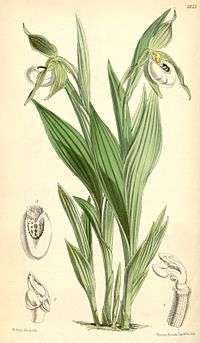Cypripedium candidum
| small white lady's slipper | |
|---|---|
 | |
| Scientific classification | |
| Kingdom: | Plantae |
| (unranked): | Angiosperms |
| (unranked): | Monocots |
| Order: | Asparagales |
| Family: | Orchidaceae |
| Subfamily: | Cypripedioideae |
| Genus: | Cypripedium |
| Species: | C. candidum |
| Binomial name | |
| Cypripedium candidum Muhl. ex Willd. | |
| Synonyms | |
|
Calceolus candidus (Muhl. ex Willd.) Nieuwl. | |
Cypripedium candidum, also known as small white lady's slipper or white lady's slipper, is a rare orchid of the Cypripedium genus.
Distribution
Cypripedium candidum is found from Western New York, across southern Ontario to North Dakota, and south to New Jersey and Missouri. There are isolated populations of Cypripedium candidum in Connecticut, Maryland[1] Manitoba, Virginia, Alabama, and (formerly) Saskatchewan.[2][3] It is found in wet prairies and fens, in rich, highly calcareous soils, sedge meadow edges, calcareous roadside and railway ditches.
Description
Cypripedium candidum grows to a height of 10 to 40 cm, and blooms from early May to June. Its white pouch-like lip, sometimes dotted with maroon on the inside, is accented by tan, green or brown lateral sepals and petals. It has been known to hybridize with the small yellow ladyslipper, C. parviflorum var. makasin, resulting in the natural hybrid Cypripedium × andrewsii. The leaves and stems are slightly pubescent. The plants grow in (generally) long-lived clumps, with some clumps having up to 50 or more flowers.
Conservation

Cypripedium candidum is considered rare across Canada, endangered in Ontario, and protected under the Ontario Endangered Species Act. It is believed to be extirpated from Saskatchewan. It is threatened in the United States, extirpated from Pennsylvania, endangered in South Dakota and Wisconsin, threatened in Illinois, Kentucky, and Michigan, and rare in Missouri and North Dakota. It is listed in Canada as N2, or endangered. Globally, however, it is listed as G4 (apparently secure) because there are protected sites across its entire range. It is a perennial, with horizontal, wiry-rooted rhizomes growing a few centimeters below the surface of the soil, and hence resistant to most prairie fires. It is shade-intolerant and therefore requires substantial management for invasive and woody species.
Cypripedium candidum is uncommon because it has a low seed set caused by often unpollinated flowers, as well as that its habitat of wet prairies and fens have been greatly decreased through draining for agricultural purposes. In Ontario, this orchid has never been common due to limited occurrences of fens in Cypripedium candidum's Southern-Ontario range. Habitat loss due to fragmentation through agriculture and development, suppression of fire, incursions by invasive species, especially reed canary grass (Phalaris arundinaceae), dogwood (cornus sp.), leafy spurge, St. John’s wort and buckthorn (rhamnus sp.), changes in hydrology, loss of pollinators and environmental challenges to the obligate mycorrhizae that support this species are all responsible for its decline. This ladyslipper is most intolerant of shade, and so management of remnant prairies needs to be a part of any species recovery strategies. Long-term monitoring of this species is being done through various scientific organizations, including the Chicago Botanic Garden's respected Plants of Concern program.
Like many wild orchids, this species has been further endangered by collecting for generally futile attempts at cultivation. It is now known from only two sites in the province of Ontario.
References
External links
| Wikimedia Commons has media related to Cypripedium candidum. |
-
 Media related to Small white lady's slipper (Cypripedium candidum) at Wikimedia Commons
Media related to Small white lady's slipper (Cypripedium candidum) at Wikimedia Commons -
 Data related to Small white lady's slipper (Cypripedium candidum) at Wikispecies
Data related to Small white lady's slipper (Cypripedium candidum) at Wikispecies